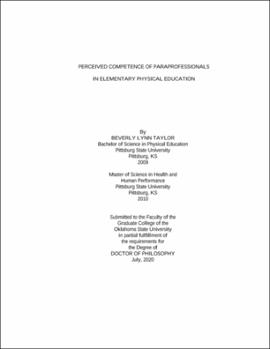| dc.contributor.advisor | Hughes, Patricia | |
| dc.contributor.author | Taylor, Beverly Lynn | |
| dc.date.accessioned | 2021-02-22T22:24:19Z | |
| dc.date.available | 2021-02-22T22:24:19Z | |
| dc.date.issued | 2020-07 | |
| dc.identifier.uri | https://hdl.handle.net/11244/328631 | |
| dc.description.abstract | The purpose of the study was to develop a preliminary instrument to ascertain the perceived competence, autonomy, and relatedness of special education paraprofessionals in elementary physical education. The Physical Education Competence Scale for Paraprofessionals (PECSP) was created from a list of paraprofessional competencies and with expert review. Participants were 138 special education paraprofessionals in the state of Oklahoma who attended physical education with one or more students during the 2019-2020 school year. The PECSP consisted of 25 questions measured on a 5-point Likert scale. Construct validity was examined through EFA, CFA, and known group differences. The researcher found five factors during the EFA analysis: Pre-Instructional Skills, Instructional Skills, Professionalism, Autonomy & Relatedness, and Feelings of Competence. After ten items with poor fit were dropped from the instrument, the CFA goodness of fit was found to be fair X2 = 109.57, df = 80, p = 0.016; CFI = 0.89; SRMR = 0.104; and RMSEA = 0.074). Undergraduate students (N = 84) completed the instrument for the known group differences test and were compared to paraprofessional results to reveal a significant difference between groups (p < 0.01). Another version of the PECSP was created for physical education teachers to evaluate paraprofessional competence. Inadequate data collection led to the inability to properly examine concurrent validity with the validity correlation coefficient. However, through an independent t-test, the investigator determined a significant difference between the two groups' responses (p < 0.01). Due to the risk of participants overinflating self-reports, this was not unexpected. Cronbach alpha coefficients revealed adequate reliability of the instrument (.83) with factor reliabilities varying from low (.36) to acceptable (.70-.90). The investigator concluded that the preliminary instrument showed moderate validity and reliability and further instrument development is needed to refine and interpret the constructs of the PECSP. | |
| dc.format | application/pdf | |
| dc.language | en_US | |
| dc.rights | Copyright is held by the author who has granted the Oklahoma State University Library the non-exclusive right to share this material in its institutional repository. Contact Digital Library Services at lib-dls@okstate.edu or 405-744-9161 for the permission policy on the use, reproduction or distribution of this material. | |
| dc.title | Perceived competence of paraprofessionals in elementary physical education | |
| dc.contributor.committeeMember | Smith, Doug | |
| dc.contributor.committeeMember | DeFreitas, Jason | |
| dc.contributor.committeeMember | Mwavita, Mwarumba | |
| osu.filename | Taylor_okstate_0664D_16818.pdf | |
| osu.accesstype | Open Access | |
| dc.type.genre | Dissertation | |
| dc.type.material | Text | |
| dc.subject.keywords | elementary school | |
| dc.subject.keywords | instrument validation | |
| dc.subject.keywords | paraprofessional | |
| dc.subject.keywords | physical education | |
| dc.subject.keywords | special education | |
| thesis.degree.discipline | Health, Leisure and Human Performance | |
| thesis.degree.grantor | Oklahoma State University | |
